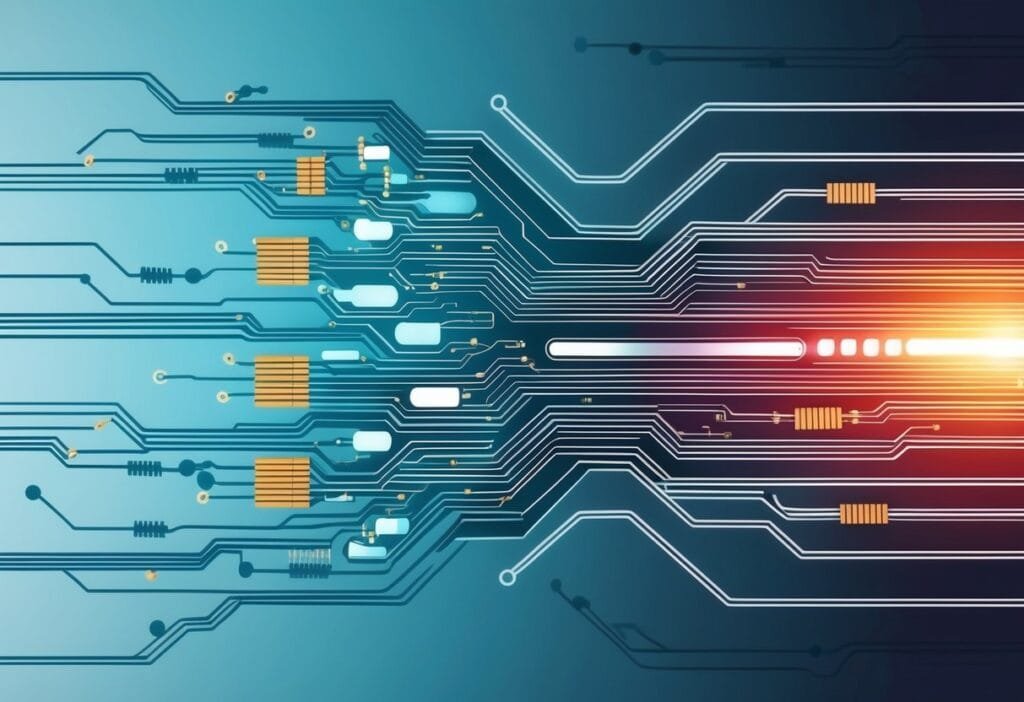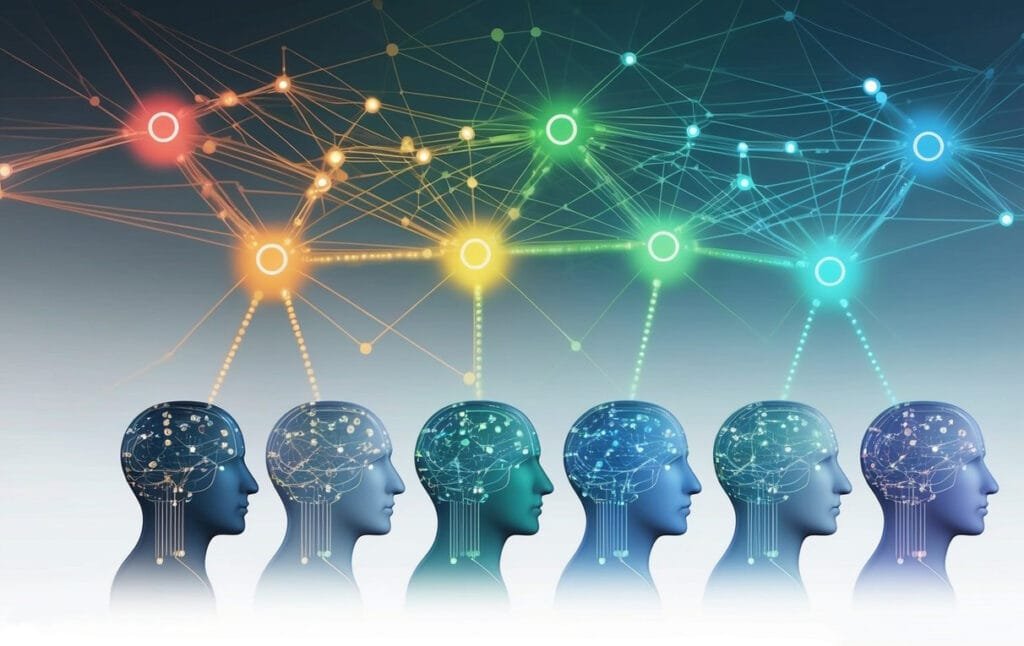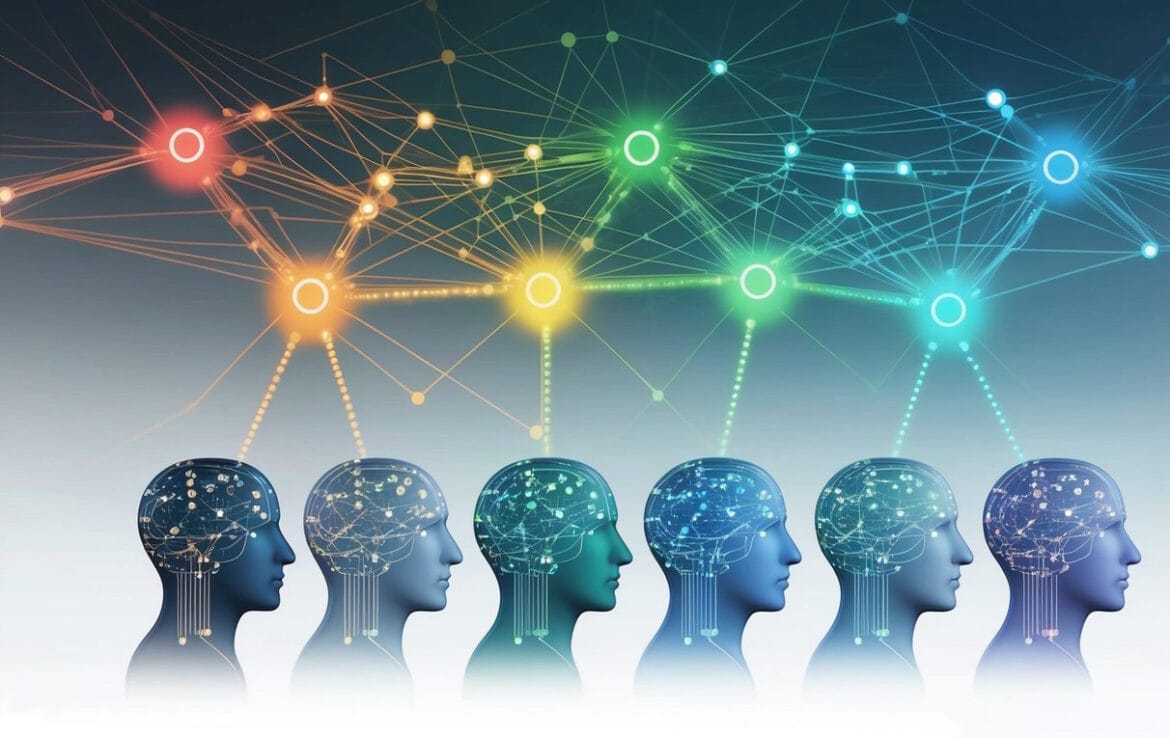Table of Contents
Explore the history of AI (artificial intelligence) to understand its impact on our world and the future of this transformative field.
Artificial intelligence has come a long way since its inception. The field has grown from basic computer programs to complex systems that can learn and adapt. AI has evolved from simple rule-based systems to sophisticated neural networks capable of solving complex problems.

The journey of AI began in the 1950s with early attempts to mimic human thinking. Over time, it has expanded to include machine learning, deep learning, and natural language processing. These advances have led to AI applications in many areas, from healthcare to finance.
Today, AI is shaping our world in ways we couldn’t have imagined. It powers virtual assistants, recommends products, and even drives cars. As AI continues to evolve, it promises to bring even more changes to how we live and work.
Summary of History of AI
- AI has progressed from basic algorithms to complex learning systems
- The field of artificial intelligence spans multiple technologies and applications
- AI’s ongoing evolution is likely to have far-reaching impacts on society and industry
The Genesis of Artificial Intelligence

Artificial intelligence emerged from foundational theories and early experiments in the mid-20th century. Key figures like Alan Turing helped establish AI as an academic field through influential ideas and tests.
Foundational Theories and Early AI
The roots of AI trace back to the 1940s and 1950s. Researchers explored ways for machines to mimic human intelligence. Early work focused on logic and problem-solving.
Scientists developed chess-playing programs and theorem-proving systems. These showed computers could handle complex tasks. Neural networks also emerged as a way to model brain function.
Key pioneers included:
- John McCarthy
- Marvin Minsky
- Allen Newell
- Herbert Simon
Their work laid the groundwork for modern AI. It showed the potential for machines to “think” in human-like ways.
Turing Test and Birth of AI as an Academic Discipline
Alan Turing proposed the Turing Test in 1950. It aimed to determine if a machine could exhibit intelligent behavior. The test became a benchmark for AI development.
In 1956, the Dartmouth Conference marked the birth of AI as a formal academic field. Researchers gathered to explore machine intelligence. They coined the term “artificial intelligence.”
The conference sparked excitement and research funding. Universities began offering AI courses. New AI labs opened at MIT, Stanford, and other institutions.
Early progress was promising. But the field soon faced challenges and setbacks. Researchers realized creating human-like intelligence was harder than expected.
Significant Milestones in AI Evolution

Artificial intelligence has undergone remarkable transformations since its inception. Key developments have shaped the field, from early logic-based approaches to modern learning models. The journey has seen both setbacks and breakthroughs.
From Logic-Based to Learning Models
The field of AI began with logic-based systems in the 1950s. These early models used rules and decision trees to solve problems. In 1956, the Dartmouth Conference marked the birth of AI as a formal discipline.
The 1960s saw the creation of ELIZA, one of the first AI chatbots. It could engage in simple conversations by pattern matching. This decade also introduced neural networks, laying groundwork for future advances.
In the 1980s, expert systems gained popularity. These programs mimicked human decision-making in specific domains. The shift towards machine learning began, with algorithms that could improve with experience.
AI Winters and Resurgences
The AI field experienced periods of reduced funding and interest, known as “AI winters“. The first occurred in the 1970s when early promises fell short. Another followed in the late 1980s and early 1990s.
Despite these setbacks, research continued. In 1997, IBM’s Deep Blue defeated world chess champion Garry Kasparov. This victory showcased AI’s potential in complex problem-solving.
The 2000s saw a resurgence in AI interest. Improved computing power and big data availability fueled new breakthroughs. Machine learning algorithms became more sophisticated, leading to practical applications.
AI Becomes Mainstream
In the 2010s, AI entered the mainstream. Deep learning models achieved human-level performance in image and speech recognition tasks. Self-driving cars began road tests, showcasing AI’s real-world potential.
Natural language processing made significant strides. In 2011, IBM’s Watson won the game show Jeopardy!, demonstrating advanced question-answering capabilities.
The 2020s have seen rapid progress in generative AI. Large language models like GPT-3 can produce human-like text, code, and even images. These advances have sparked discussions about AI’s impact on various industries and society as a whole.
Core Technologies that Shaped AI

AI’s growth stems from key technological breakthroughs. These advances enabled machines to process information and learn in ways that mimic human intelligence.
Algorithmic Advancements
Early AI relied on rule-based systems and expert knowledge. This approach had limits. In the 1980s, machine learning algorithms emerged. These allowed computers to improve with experience.
Decision trees helped classify data into categories. Support vector machines found patterns in complex datasets. Random forests combined multiple decision trees for better accuracy.
Reinforcement learning algorithms enabled AI to learn through trial and error. This led to breakthroughs in game-playing AI. Deep Q-networks mastered Atari games. AlphaGo beat world champions at Go.
Natural language processing improved with statistical methods. This paved the way for better machine translation and speech recognition.
Rise of Neural Networks and Deep Learning
Neural networks, inspired by the human brain, revolutionized AI. These interconnected layers of artificial neurons can learn complex patterns.
Deep learning, using many-layered neural networks, drove major AI advances. Convolutional neural networks excelled at image recognition. Recurrent neural networks processed sequential data like text and speech.
Transformer models, introduced in 2017, transformed natural language processing. They enabled more accurate translations and human-like text generation.
Graphics processing units (GPUs) sped up neural network training. This allowed for larger, more powerful models. Cloud computing made these resources widely accessible.
AI, Data, and Computational Power

The growth of AI relies on big data and powerful computers. These factors shape how AI systems learn and improve over time.
Influence of Big Data
Big data fuels AI development. Large datasets help AI models learn patterns and make better predictions. Companies collect vast amounts of user data from websites, apps, and devices. This data trains AI systems to understand human behavior and preferences.
AI needs diverse data to work well. Text, images, videos, and sensor readings all play a role. More data usually means smarter AI. But data quality matters too. Clean, well-labeled data leads to more accurate AI models.
Privacy concerns arise with big data use. Some worry about how companies gather and use personal information. Balancing data needs with privacy rights is an ongoing challenge in AI.
Compute and AI Capabilities
Computational power drives AI progress. Faster processors and more memory allow for bigger, more complex AI models. This leads to AI that can handle harder tasks.
AI training often uses specialized hardware like GPUs. These chips process data much faster than regular computer parts. Cloud computing also helps by providing massive processing power on demand.
More compute lets AI tackle tougher problems. It enables techniques like deep learning, which use huge neural networks. These networks can find subtle patterns in data that simpler models miss.
The amount of compute used for AI has grown rapidly. Top AI models now use millions of times more processing power than early systems. This growth shows no signs of slowing down.
Human and Machine Intelligence Interaction

Humans and AI systems interact in complex ways. This relationship shapes how AI develops and impacts society. Scientists study how machines can learn from human cognition.
Cognitive Science and AI
Cognitive science explores how the human mind works. It helps AI researchers design systems that think more like people. AI models try to copy human memory, reasoning, and learning.
Scientists map brain activity to understand intelligence. This informs AI architecture. Neural networks in AI mimic how brain cells connect.
AI struggles with some tasks humans find easy. These include understanding context and being creative. Researchers study human problem-solving to improve AI capabilities.
AI Mimicking Human Intelligence
AI aims to replicate human intelligence in machines. This includes learning, planning, and solving problems.
Current AI excels at narrow tasks. It can play chess or recognize speech. But it lacks human-like general intelligence.
Some AI uses human-inspired algorithms. These copy how people learn and make decisions. Other systems use different methods that may surpass human abilities in specific areas.
Ethical questions arise as AI mimics human traits. People debate the risks and benefits of machines that think like humans.
Turing Test Evolution
The Turing Test measures if AI can fool humans. A machine passes if people can’t tell it apart from a human in conversation.
Early versions used text chats. Modern tests are more complex. They may include visual or audio elements.
Some experts say the test is flawed. It doesn’t truly measure intelligence. New benchmarks focus on specific skills like reasoning or creativity.
AI has improved at mimicking human chat. But passing the Turing Test doesn’t mean true human-level intelligence. The test continues to evolve as AI advances.
Application Domains of AI

AI has transformed many industries with its powerful capabilities. It enhances products and services across diverse fields, making our lives easier and more efficient.
Speech and Image Recognition
Speech recognition allows computers to understand and respond to human voices. It powers virtual assistants like Siri and Alexa, enabling hands-free device control and dictation.
Image recognition lets machines identify objects, faces, and scenes in photos and videos. This tech is used in security systems, social media tagging, and medical imaging.
Both speech and image recognition have improved greatly in recent years. They now approach or exceed human-level accuracy in many tasks.
Autonomous Systems
Self-driving cars are a prime example of autonomous systems. They use AI to navigate roads, avoid obstacles, and follow traffic rules without human input.
Drones and robots also rely on AI for autonomous operation. They’re used in various settings like warehouses, farms, and disaster zones.
AI-powered autonomous systems are making workplaces safer and more efficient. They can handle dangerous or repetitive tasks, freeing humans for more complex work.
AI in Healthcare and Robotics
AI is revolutionizing healthcare through better diagnosis and treatment planning. Machine learning algorithms can analyze medical images to detect diseases early and accurately.
Robots assisted by AI perform complex surgeries with precision. They help reduce human error and improve patient outcomes.
AI also aids in drug discovery, predicting protein structures, and personalizing treatment plans. This speeds up research and makes healthcare more effective for individual patients.
AI Systems and Models

AI systems and models have transformed how computers process information. They enable machines to understand language, generate content, and solve complex problems in new ways.
Generative AI and Language Models
Generative AI can create new content like text, images, and code. Large language models are a key type of generative AI. They process and produce human-like text.
Some well-known language models include:
- GPT (Generative Pre-trained Transformer)
- BERT (Bidirectional Encoder Representations from Transformers)
- T5 (Text-to-Text Transfer Transformer)
These models learn patterns from vast amounts of text data. They can then generate new text, answer questions, and translate languages.
Language models have many uses. They power chatbots, writing assistants, and code completion tools. Their ability to understand context makes them valuable for tasks like sentiment analysis and text summarization.
AI Systems Integration
AI systems integration combines AI models with existing software and processes. This creates more powerful and flexible tools for businesses and organizations.
Integrated AI systems can:
- Analyze data from multiple sources
- Automate complex workflows
- Provide insights for decision-making
For example, a customer service system might use AI to:
- Understand customer queries
- Access relevant information
- Generate helpful responses
Integration allows AI to work with databases, APIs, and other software. This makes AI more useful in real-world applications.
Challenges in AI integration include:
- Ensuring data privacy and security
- Managing system complexity
- Balancing automation with human oversight
As AI technology advances, integrated systems will become more common and sophisticated.
AI and Society

AI is changing how we live and work. It brings new possibilities but also raises important questions about ethics and jobs.
Ethical Implications of AI
AI systems make choices that affect people’s lives. This raises concerns about fairness and privacy. AI can make biased decisions if not designed carefully. For example, some AI hiring tools have shown bias against certain groups.
Privacy is another key issue. AI needs lots of data to work well. But collecting this data can invade people’s privacy. Companies and governments must balance AI benefits with protecting personal information.
AI also brings up questions about human control. As AI gets smarter, some worry it may become hard for humans to oversee. Clear rules are needed to keep AI safe and trustworthy.
AI’s Impact on Economy and Everyday Life
AI is changing many jobs. It can do some tasks faster and better than humans. This may lead to job losses in some fields. But it also creates new jobs working with AI systems.
In daily life, people interact with AI more often. AI powers smartphone assistants, recommends products, and helps drive cars. It makes many tasks easier and more personalized.
AI is improving healthcare too. It can spot diseases early and help create new medicines. In education, AI tutors adapt to each student’s needs.
As AI keeps evolving, its effects on society will grow. Staying informed about AI helps people prepare for these changes.
The Future Trajectory of AI

AI is advancing rapidly. It’s moving from narrow applications to more general capabilities. Experts predict major breakthroughs in the coming decades.
From Narrow AI to Artificial General Intelligence
Today’s AI excels at specific tasks like playing chess or recognizing speech. This is called narrow AI. The next big leap is artificial general intelligence (AGI). AGI would match human-level intelligence across many domains.
Researchers are working to expand AI’s abilities. They aim to create systems that can learn and reason like humans. This includes:
• Understanding context
• Applying knowledge to new situations
• Solving complex problems
Progress is steady, but AGI is still years away. Estimates for when we’ll achieve AGI range from 2040 to 2060.
Predictions and Potential
AI’s future impact could be enormous. Experts foresee advances in:
• Medicine: AI may discover new treatments and speed up drug development.
• Climate change: AI could optimize energy use and find innovative solutions.
• Space exploration: AI might control autonomous spacecraft and analyze data.
Some predict AI breakthroughs could win a Nobel Prize in the future. This would recognize AI’s contributions to science and society.
AI spending is rising fast. It’s expected to reach $79.2 billion by 2022. This growth shows AI’s increasing importance in various industries.

